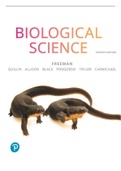Lophotrochozoans Study guides, Class notes & Summaries
Looking for the best study guides, study notes and summaries about Lophotrochozoans? On this page you'll find 9 study documents about Lophotrochozoans.
All 9 results
Sort by

-
BIOL 198 Module 7 Exam Questions With 100% Correct Answers
- Exam (elaborations) • 18 pages • 2024
- Available in package deal
-
- $12.49
- + learn more
BIOL 198 Module 7 Exam Questions With 100% Correct Answers Identify the characteristics that distinguish animals from other types of organisms. - answerMulticellular Heterotrophic Motile Reproduce sexually Use aerobic metabolism Lack cell walls Have life cycles that include development from undifferentiated cells Have a variety of body plans Distinguish between asymmetry, radial symmetry, and bilateral symmetry. - answerAsymmetry: no particular organization Radial symmetry: Circular...

-
BIOL 198 Module 7 Exam Questions With 100% Correct Answers
- Exam (elaborations) • 18 pages • 2024
-
- $12.49
- + learn more
BIOL 198 Module 7 Exam Questions With 100% Correct Answers Identify the characteristics that distinguish animals from other types of organisms. - answerMulticellular Heterotrophic Motile Reproduce sexually Use aerobic metabolism Lack cell walls Have life cycles that include development from undifferentiated cells Have a variety of body plans Distinguish between asymmetry, radial symmetry, and bilateral symmetry. - answerAsymmetry: no particular organization Radial symmetry: Circular...

-
BIOL 198 Module 7 Objectives Questions & Answers Already Passed!!
- Exam (elaborations) • 19 pages • 2024
- Available in package deal
-
- $6.79
- + learn more
Identify the characteristics that distinguish animals from other types of organisms. - Answer-Multicellular Heterotrophic Motile Reproduce sexually Use aerobic metabolism Lack cell walls Have life cycles that include development from undifferentiated cells Have a variety of body plans Distinguish between asymmetry, radial symmetry, and bilateral symmetry. - Answer-Asymmetry: no particular organization Radial symmetry: Circularly organized. If cut in half vertically, the halves will loo...

-
BIOL211 animals exam study guide
- Other • 18 pages • 2021
-
- $5.49
- 1x sold
- + learn more
This is my study guide for my upcoming biology exam, all about animals. It briefly goes over all topics we have covered in these last few weeks of class, including the topics surrounding animal development, the Cambrian explosion, Porifera and cnidaria, neurons and sensory mechanisms in animals, triploblastic development, muscles, Lophotrochozoans, Deuterostomes, circulation in animals, gas exchange, the Gnathostomes, tetrapods and amniotes, and mammals. I hope you enjoy my notes!

-
Exam review (of Kingdom Animalia with organization)
- Summary • 2 pages • 2022
-
- $10.49
- + learn more
I have color coded and organized the groups of animals into protostomes, deuterostomes, and the phylum within along with important characteristics. There is also information on thermoregulation within the animals and maintaining homeostasis.

-
BIO 181 FINAL STUDY GUIDE, Latest complete guide (fall 2019/2020)
- Other • 82 pages • 2021
-
- $12.49
- + learn more
BIO 181 FINAL STUDY GUIDE Lecture #1: 1. How did the four macromolecules appear on early earth? Components of “Primitive Soup” Carbohydrates, Lipids, Nucleic Acids, Proteins (four macromolecules of life) We don’t have a clear answer but there are numerous hypotheses. 2. List and explain the basis/ background for the four main theories of how life originated on early earth. Are there any challenges these theories have to overcome? a) Oparin-Haldane Hypothesis (tested by Miller-Urey) a. ...

-
Biological Science, Canadian Edition., 2e (Freeman et al.) UPDATED VERSION
- Exam (elaborations) • 807 pages • 2021
-
- $17.99
- + learn more
Contents Chapter 1 Biology and the Tree of Life 1 1.1 The Cell Theory 2 Are All Organisms Made of Cells? 2 Where Do Cells Come From? 2 1.2 The Theory of Evolution by Natural Selection 4 What Is Evolution? 4 What Is Natural Selection? 4 1.3 The Tree of Life 5 Linnaean Taxonomy 6 BOX 1.1 Scientific Names and Terms 6 Using Molecules to Understand the Tree of Life 8 1.4 Doing Biology 10 Why Do Giraffes Have Long Necks? An Introduction to Hypothesis Testing 10 Why Are Chili Peppers Hot? An ...

-
BIO 181 FINAL STUDY GUIDE, Latest complete guide (fall 2019/2020)
- Study guide • 83 pages • 2020
-
- $15.49
- + learn more
BIO 181 FINAL STUDY GUIDE Lecture #1: 1. How did the four macromolecules appear on early earth? Components of “Primitive Soup” Carbohydrates, Lipids, Nucleic Acids, Proteins (four macromolecules of life) We don’t have a clear answer but there are numerous hypotheses. 2. List and explain the basis/background for the four main theories of how life originated on early earth. Are there any challenges these theories have to overcome? a) Oparin-Haldane Hypothesis (tested by Miller-Urey) a....

-
Protostomes
- Class notes • 8 pages • 2020
- Available in package deal
-
- $7.49
- + learn more
This is a comprehensive and organized note set on Protostomes with key concepts and terms on lophotrochozoa, ecdysozoa, flatworms, annelids, mollusks, roundworms, arthropods, etc



